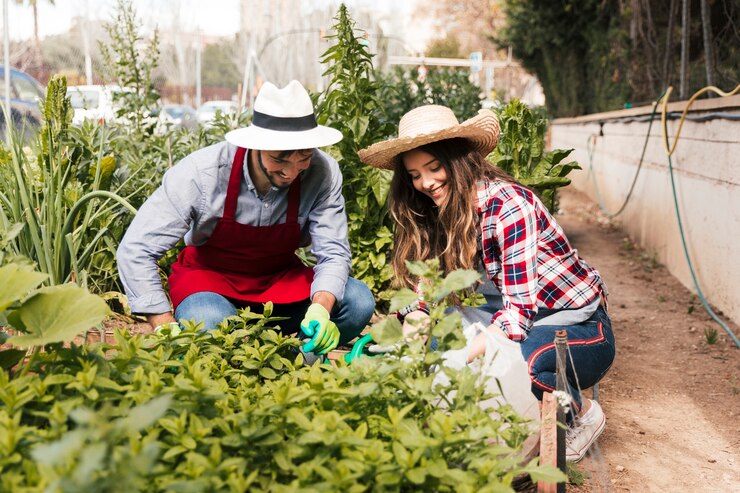Dreaming of a bountiful harvest right in your backyard? This comprehensive guide will help you transform your large yard into a thriving food oasis. From selecting the perfect plants to optimizing your growing space, we’ll cover everything you need to know to grow your own food and cultivate a sustainable garden. Whether you’re a seasoned gardener or a vegan, you’ll find valuable tips and tricks to achieve self-sufficiency and enjoy the fruits of your labor.
Ready to embark on this rewarding journey to vegan life? Dive into this article to discover the secrets of successful gardening, from choosing the right seeds and soil to effective watering and pest control. Let’s cultivate a greener future, one plant at a time!
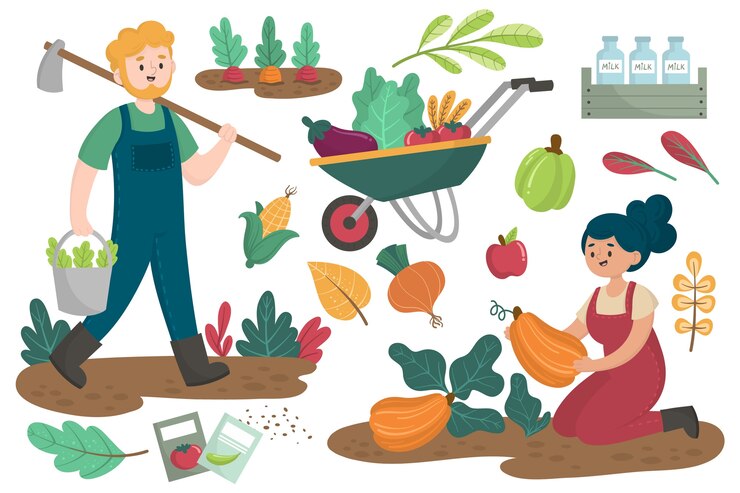
The Joy of Homegrown Produce
There’s an undeniable satisfaction in harvesting fresh, homegrown produce. The taste, the aroma, and the knowledge that you’ve nurtured these plants from seed to table is truly rewarding. Homegrown fruits and vegetables are often more flavorful and nutritious than store-bought produce, as they are picked at the peak of ripeness.
Even if you don’t have a sprawling backyard, you can still enjoy the benefits of home gardening. Whether you live in an apartment, condo, or a small house, there are creative ways to cultivate your own food. From windowsill herbs to container gardens on balconies, you can maximize your space and grow a variety of vegetables, fruits, and herbs.
Choosing the Right Containers
The type of container you choose will depend on your available space, the type of plants you want to grow, and your personal preference.
Pots: Traditional pots come in various shapes, sizes, and materials, such as ceramic, terracotta, or plastic. They’re versatile and can be placed on balconies, patios, or indoors.
Grow Bags: These flexible containers are ideal for root vegetables like potatoes and carrots. They allow for better drainage and aeration, promoting healthy plant growth.
Window Boxes: Perfect for small spaces, window boxes can be filled with herbs, flowers, or small vegetables like lettuce and strawberries. They add a touch of greenery to your home and provide easy access to fresh produce.
Factors to Consider
When selecting containers, consider the following factors:
Size: The size of the container should be appropriate for the plant species you intend to grow. Ensure there’s enough room for the roots to spread and the plant to mature.
Drainage: Adequate drainage is crucial to prevent waterlogging, which can lead to root rot. Choose containers with drainage holes or drill your own.
Material: The material of the container can affect its weight, durability, and water retention. Terracotta pots are porous and allow excess moisture to evaporate, while plastic pots are lightweight and durable.
Sun and Aspect Considerations
Most vegetables thrive in full sun, which means they need at least six to eight hours of direct sunlight each day. This sunlight is essential for photosynthesis, the process by which plants convert sunlight into energy. However, some vegetables, like lettuce and spinach, can tolerate partial shade, which means they can grow in areas that receive four to six hours of sunlight.
If your space receives limited sunlight, don’t worry! You can still grow a variety of vegetables and herbs. Opt for shade-tolerant plants like lettuce, spinach, and herbs like mint and parsley. Additionally, consider using grow lights to supplement natural light, especially during the winter months. By strategically placing your containers and utilizing artificial light, you can create a thriving garden even in low-light conditions.
Automated Watering Systems
Automated watering systems offer numerous advantages for home gardeners:
- These systems deliver water directly to the root zone, minimizing evaporation and runoff. This efficient use of water can significantly reduce your water bill.
- By automating the watering process, you can free up valuable time. You won’t have to worry about manually watering your plants, especially during busy periods or vacations.
- Automated systems ensure that your plants receive the right amount of water at the right time. This consistency promotes healthy plant growth and reduces the risk of overwatering or underwatering.
- Many automated systems can be controlled remotely using smartphone apps. This allows you to monitor and adjust your watering schedule, even when you’re away from home.
- Some systems have sensors that can detect soil moisture levels. This prevents overwatering, which can lead to root rot and other plant diseases.
DIY and Commercial Options
There are various DIY and commercial options for automated watering systems, each with its own set of features and benefits.
- Soaker Hoses: A simple and affordable option, soaker hoses release water slowly and evenly along their length. They can be manually turned on and off or connected to a timer.
- Drip Irrigation Systems: These systems deliver water directly to the root zone of plants, minimizing water waste. DIY drip irrigation systems typically involve a water source, tubing, emitters, and a timer.
- Self-Watering Containers: These containers have a reservoir that slowly releases water to the plant’s roots, reducing the need for frequent watering.
- Smart Garden Systems: These advanced systems often include features like automated lighting, climate control, and nutrient delivery. Popular brands include Click & Grow and AeroGarden.
- Wi-Fi-Enabled Controllers: These controllers allow you to monitor and control your watering system remotely using a smartphone app. You can set custom watering schedules, adjust water flow, and receive notifications about system status.
- Soil Moisture Sensors: These sensors measure the moisture level in the soil and automatically trigger the watering system when needed. This helps prevent overwatering and underwatering.
By choosing the right automated watering system, you can create a thriving garden with minimal effort.
Fertilizer and Soil
Plants require a variety of nutrients to grow and thrive. These nutrients can be broadly categorized into macronutrients and micronutrients.
- Nitrogen (N): Essential for the production of chlorophyll, which gives plants their green color. It promotes healthy leaf growth and overall plant vigor.
- Phosphorus (P): Crucial for root development, flower formation, and seed production. It plays a vital role in energy transfer within plants.
- Potassium (K): Helps regulate water balance, activates enzymes, and improves disease resistance. It also enhances fruit quality and flavor.
While needed in smaller quantities, micronutrients are equally important for plant health. They include:
- Calcium (Ca): Essential for cell wall structure and fruit development.
- Magnesium (Mg): Involved in chlorophyll production and photosynthesis.
- Sulfur (S): Component of proteins and vitamins, promoting healthy growth.
- Iron (Fe): Necessary for chlorophyll production and energy transfer.
- Manganese (Mn): Activates enzymes involved in photosynthesis and respiration.
- Zinc (Zn): Essential for hormone production and enzyme activity.
- Copper (Cu): Involved in photosynthesis and respiration.
- Boron (B): Important for cell division and pollen tube growth.
- Molybdenum (Mo): Required for nitrogen fixation and enzyme activity.
- Chlorine (Cl): Plays a role in photosynthesis and water balance.
By understanding the essential nutrients and their roles in plant growth, you can provide your plants with the optimal conditions to thrive.

Choosing the Right Fertilizer
Choosing the right fertilizer is crucial for healthy plant growth. The best fertilizer for your garden will depend on your soil’s nutrient content and the specific needs of your plants.
Before applying any fertilizer, it’s recommended to conduct a soil test. This will help you determine the pH level and nutrient deficiencies in your soil. A soil test can provide tailored recommendations for fertilization.
- Chemical Fertilizers: These fertilizers provide specific nutrients in a concentrated form. They are often labeled with an N-P-K ratio, which indicates the percentage of nitrogen, phosphorus, and potassium, respectively.
- Organic Fertilizers: Derived from natural sources like compost, manure, and plant-based materials, organic fertilizers release nutrients slowly and improve soil health.
- Time-Release Fertilizers: These fertilizers release nutrients gradually over time, reducing the need for frequent applications.
Follow the instructions on the fertilizer label carefully. Over-fertilization can harm plants and damage the environment. Consider using a fertilizer spreader to ensure even distribution.
Remember, healthy soil is the foundation for healthy plants. By choosing the right fertilizer and applying it correctly, you can provide your garden with the essential nutrients it needs to thrive.
Soil Requirements for Different Plants
Different plants have specific soil requirements to thrive. Here are some common soil preferences:
- Acid-Loving Plants: Plants like blueberries, azaleas, and rhododendrons prefer acidic soil with a pH level below 7.0. You can amend your soil with peat moss or sulfur to lower the pH.
- Alkaline-Loving Plants: Certain plants, such as lilacs and peonies, prefer alkaline soil with a pH level above 7.0. You can raise the pH of your soil by adding lime.
- Neutral Soil Plants: Most vegetables and herbs prefer neutral soil with a pH level between 6.0 and 7.0. Well-draining, fertile soil is ideal for these plants.
- Well-Drained Soil: Many plants, especially those grown in containers, require well-draining soil to prevent root rot. You can improve drainage by adding perlite, vermiculite, or sand to your potting mix.
- Rich Organic Matter: Most plants benefit from soil rich in organic matter, such as compost or well-rotted manure. Organic matter improves soil structure, water retention, and nutrient availability.
By understanding the specific soil requirements of your plants, you can create the optimal growing conditions for a thriving garden.
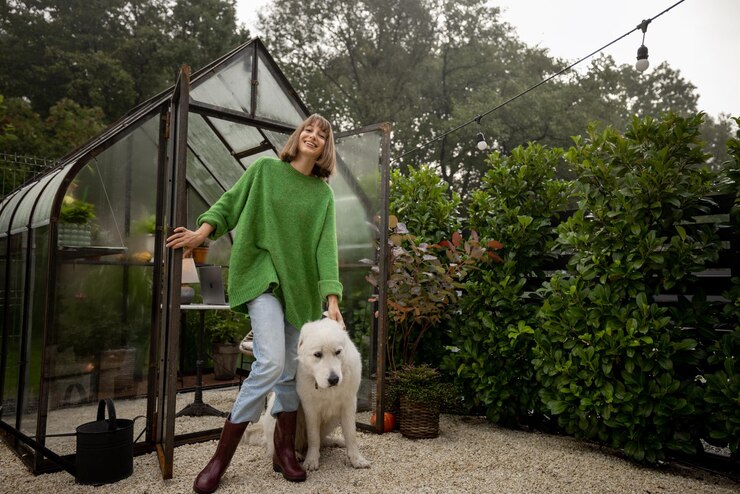
Pet-Friendly Gardening
To safeguard your garden from pets, consider the following strategies:
- Physical Barriers: A sturdy fence can effectively keep pets out of your garden. Ensure the fence is tall enough to deter jumping and burying. By elevating your garden beds, you can make them less accessible to digging pets. Covering your plants with netting can protect them from curious paws and nibbling mouths.
- Plant Selection: Choose plants that are less appealing to pets. Some pet-resistant options include herbs like rosemary and lavender, and ornamental grasses. Research plants that are toxic to pets and avoid planting them in your garden. Common toxic plants for pets include lilies, oleander, and sago palm.
- Deterrents: Use commercial pet repellents or homemade solutions like citrus sprays to deter pets from your garden. Some pets are sensitive to certain textures or smells. Consider using prickly plants or strong-smelling herbs to discourage them. Train your pets to stay out of the garden. Positive reinforcement techniques, such as rewards and praise, can be effective in teaching your pet appropriate behavior.
By combining these strategies, you can create a pet-friendly garden that both you and your furry companions can enjoy.
Choosing Pet-Resistant Plants
When selecting plants for your garden, consider choosing varieties that are less appealing to pets. Here are some pet-resistant plant options:
- Strong-Smelling Herbs: Many herbs, such as rosemary, lavender, and sage, have strong scents that can deter pets. These plants can also add beauty and fragrance to your garden.
- Prickly Plants: Plants with prickly leaves or stems, like cacti and roses, can discourage pets from nibbling or rubbing against them.
- Ornamental Grasses: Grasses like fescue and ornamental grasses can add texture and movement to your garden while being less tempting to pets.
- Tough-Leaved Plants: Plants with thick, leathery leaves, such as succulents and certain varieties of hostas, are less likely to be damaged by pets.
Remember, while these plants are less likely to be targeted by pets, no plant is completely pet-proof. It’s important to supervise pets in the garden, especially if they have a history of destructive behavior.
Easiest and Fastest-Growing Vegetables
For beginner gardeners or those with limited time, lettuce, spinach, and radishes are excellent choices for a low-maintenance garden. These cool-season crops are relatively easy to grow and can be harvested quickly.
Lettuce: This versatile leafy green comes in various types, from crisphead to loose-leaf. Lettuce prefers cool temperatures and consistent moisture. It can be grown in containers or directly in the ground. To prevent bolting (premature flowering), harvest lettuce regularly or plant successive crops.
Spinach: A nutrient-packed leafy green, spinach is a cool-season crop that thrives in rich, well-drained soil. It can be grown in containers or directly in the ground. To keep spinach producing, harvest the outer leaves, leaving the inner leaves to continue growing.
Radishes: These quick-growing root vegetables are perfect for impatient gardeners. Radishes prefer cool weather and well-drained soil. They can be harvested in as little as 20-30 days. To prevent them from becoming woody, harvest radishes before they become too large.
Tomatoes: These versatile fruits (yes, tomatoes are technically fruits) can be grown in various forms, including vine-ripe, cherry, and grape. Tomatoes require plenty of sunlight, warm temperatures, and well-drained soil. To support heavy fruit loads, consider using cages or stakes.
Cucumbers: These refreshing vegetables come in various shapes and sizes, from slicing cucumbers to pickling cucumbers. Cucumbers are vine crops that require plenty of space to climb. Provide them with a trellis or fence to support their growth.
Zucchini: This prolific vegetable can produce a large number of fruits in a short period. Zucchini prefers warm temperatures and well-drained soil. To keep zucchini plants producing, harvest the fruits regularly.
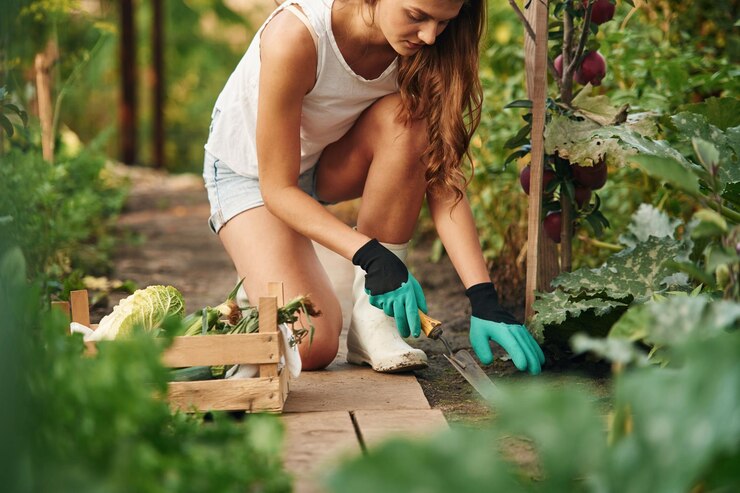
Benefits of Homegrown Produce
Homegrown, organic produce offers a multitude of health benefits. When you consume fresh, locally grown fruits and vegetables, you’re often getting them at their peak ripeness, which means they are packed with essential vitamins, minerals, and antioxidants. These nutrients are crucial for maintaining optimal health and boosting your immune system.
Additionally, organic farming practices minimize the use of harmful pesticides and synthetic fertilizers. By reducing exposure to these chemicals, you can lower your risk of developing certain health problems, such as cancer and neurological disorders. Moreover, organic foods are often more flavorful and nutrient-dense than conventionally grown produce.
Home gardening can have a significant positive impact on the environment. By growing your own food, you can reduce your carbon footprint in several ways:
- Reduced Food Miles: Homegrown produce eliminates the need for long-distance transportation, which reduces greenhouse gas emissions associated with shipping food.
- Conservation of Water and Energy: By practicing water-wise gardening techniques, such as using rainwater harvesting and drip irrigation, you can conserve water resources. Additionally, home gardening can reduce the energy consumption associated with food production, processing, and transportation.
- Soil Health and Biodiversity: Home gardening promotes healthy soil through composting and other sustainable practices. Healthy soil sequesters carbon, improves water retention, and supports a diverse ecosystem of beneficial organisms.
- Reduced Pesticide Use: Home gardeners can minimize the use of chemical pesticides by employing natural pest control methods, such as attracting beneficial insects and using organic pest repellents. This helps protect pollinators and other wildlife.
- Increased Biodiversity: Home gardens can provide habitat for various pollinators, birds, and other wildlife. By planting a variety of flowers, shrubs, and trees, you can create a mini-ecosystem that supports biodiversity.
By embracing sustainable gardening practices, you can contribute to a healthier planet and a more resilient food system.
Raised Garden Beds: A Space-Saving Solution
Raised garden beds offer a multitude of advantages for both novice and experienced gardeners. Here are some key benefits:
Improved Soil Quality: Raised beds allow you to create custom soil mixes tailored to your plants’ specific needs. You can fill them with high-quality compost, well-draining soil, and other amendments to ensure optimal growing conditions.
Enhanced Drainage: Raised beds promote excellent drainage, preventing waterlogging and root rot. This is especially beneficial in areas with heavy clay soil or poor drainage.
Reduced Weed Pressure: The raised bed design creates a physical barrier between your garden and surrounding weeds, making weed control significantly easier.
Warmer Soil: Raised beds warm up faster in the spring, allowing you to start planting earlier in the season. This can lead to earlier harvests and extended growing seasons.
Better Accessibility: Raised beds are easier to access, especially for individuals with mobility limitations. They reduce the need for bending and kneeling, making gardening more comfortable.
Increased Productivity: The improved soil quality, drainage, and growing conditions in raised beds often lead to higher yields and healthier plants.
By incorporating raised beds into your garden, you can enjoy a more productive, efficient, and enjoyable gardening experience.
Creating a raised bed in small spaces
Even in small spaces, you can create a productive raised bed garden. Here are some tips for maximizing your space:
Choose the Right Size: Opt for a smaller raised bed, such as a 4×4 foot or 3×3 foot bed. This size is manageable and can be easily placed on a balcony, patio, or even a small backyard.
Utilize Vertical Space: Maximize your growing space by using vertical gardening techniques. Train vining plants like peas, beans, and cucumbers to climb trellises or fences. You can also use hanging baskets or wall-mounted planters for herbs and small vegetables.
Choose Compact Varieties: Select compact or dwarf varieties of vegetables to save space. These varieties produce smaller fruits or vegetables but still offer a good harvest.
Succession Planting: Plant different crops at staggered intervals to maximize your harvest. For example, you can plant early-season crops like lettuce and radishes, followed by warm-season crops like tomatoes and peppers.
Container Gardening: If space is truly limited, consider container gardening. You can grow a variety of vegetables, herbs, and even small fruits in pots or containers. Choose containers with drainage holes and fill them with a high-quality potting mix.
By following these tips, you can create a thriving raised bed garden, even in the smallest of spaces.
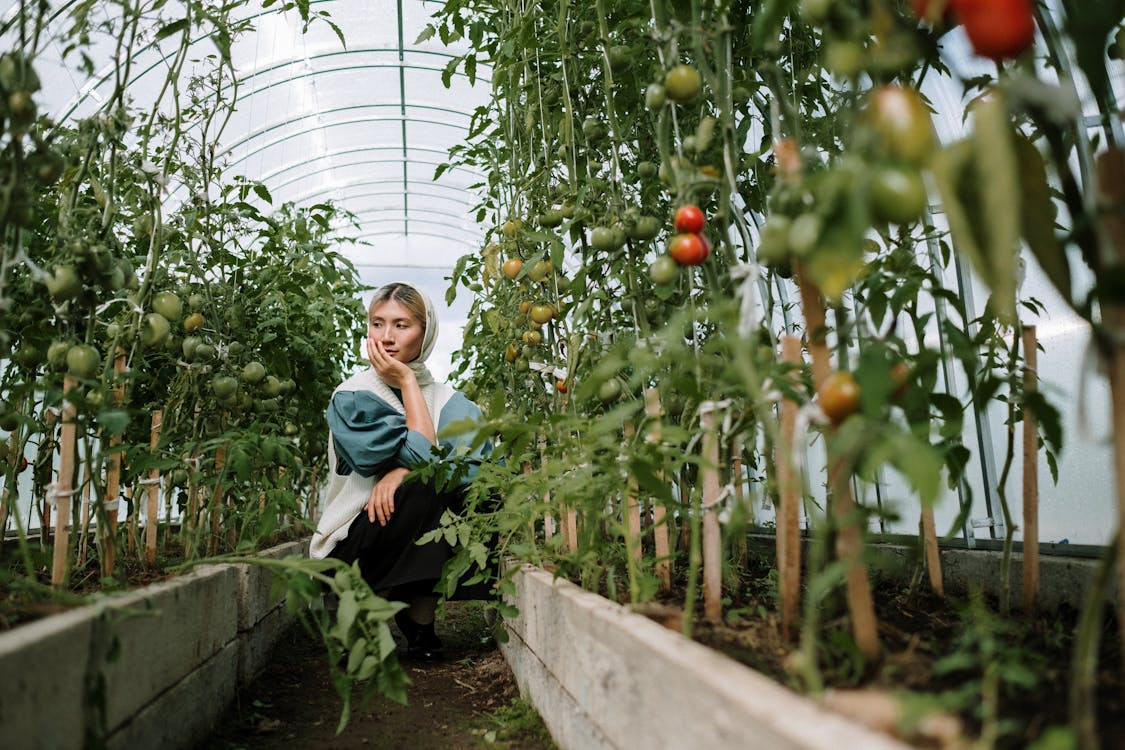
Companion Planting
Companion planting is a gardening technique that involves planting different crops together to improve their health, productivity, and flavor. The science behind companion planting is rooted in the complex interactions between plants, including:
- Some plants can repel pests that commonly attack other crops. For example, marigolds can deter nematodes, while nasturtiums can distract aphids from tomatoes.
- Certain plants, such as dill and fennel, attract beneficial insects like ladybugs and lacewings, which prey on harmful pests.
- Leguminous plants like peas and beans fix nitrogen in the soil, making it more fertile for other plants.
- Some plants can enhance the flavor of neighboring plants. For example, basil can improve the flavor of tomatoes.
- Tall plants like corn can provide support for vining plants like beans, optimizing space utilization.
- Larger plants can provide shade for smaller, more delicate plants, protecting them from harsh sunlight and helping to retain soil moisture.
By understanding the science behind companion planting, you can create a more harmonious and productive garden.
Effective Plant Pairings
Here are some effective plant pairings to consider for your garden:
- Tomatoes and Basil: Basil can help deter pests and improve the flavor of tomatoes.
- Carrots and Onions: The strong scent of onions can repel carrot flies.
- Peas and Carrots: Peas fix nitrogen in the soil, benefiting the growth of carrots.
- Cabbage and Nasturtiums: Nasturtiums can distract cabbage white butterflies.
- Marigolds and Many Plants: Marigolds can deter nematodes and other pests, making them beneficial companions for many plants.
- Lettuce and Radishes: These cool-season crops can be planted together to maximize space utilization.
- Cucumbers and Squash: These vining plants can be trained together on a trellis or fence to save space.
Remember that these are just a few examples, and the best plant pairings may vary depending on your specific climate and growing conditions. Experimentation is key to discovering the most effective combinations for your garden.
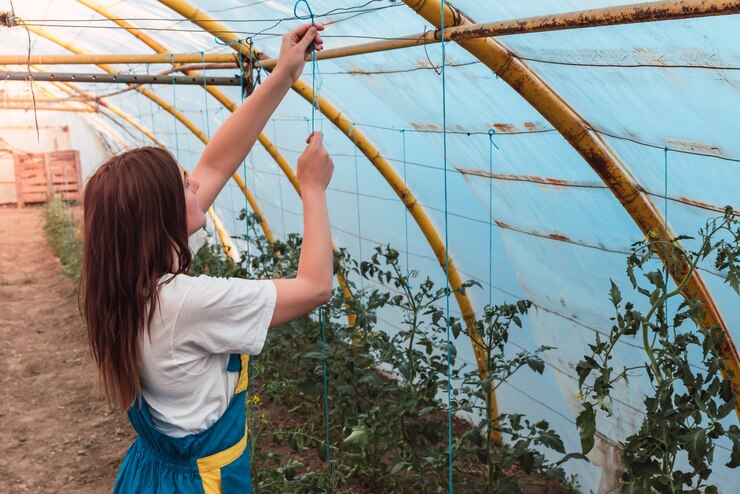
Plant Support and Staking
Staking plants is a common gardening practice that involves providing support to plants, particularly those with weak stems or heavy fruit loads. Here’s when and why you should consider staking your plants:
When to Stake:
Top-Heavy Plants: Plants with large flowers, fruits, or foliage, such as tomatoes, peppers, and sunflowers, can become top-heavy and prone to breaking.
Tall, Slender Plants: Plants with long, slender stems, like delphiniums and lilies, may need support to prevent them from flopping over in strong winds or heavy rain.
Climbing Plants: Vines and climbing plants, such as peas, beans, and cucumbers, require support to grow vertically.
Why Stake:
Prevent Damage: Staking helps prevent plants from breaking or bending, especially during periods of high winds or heavy rain.
Promote Healthy Growth: By keeping plants upright, staking allows for better air circulation and sunlight exposure, promoting healthy growth and development.
Maximize Fruit Production: Staking can help plants produce more fruit by ensuring that the weight of the fruit is evenly distributed.
Improve Aesthetics: Staked plants often look more attractive and orderly, enhancing the overall appearance of your garden.
Remember to use soft, flexible materials like garden twine or cloth strips to tie your plants to the stakes. Avoid using wire or other materials that can damage the plant’s stem.
Staking Techniques for Different Vegetables
Here are some common staking techniques for different vegetables:
Tomatoes: A tomato cage provides all-around support for the plant. As the plant grows, gently tie the main stem to the cage. Use a single stake and tie the main stem to it as the plant grows. This method works well for smaller varieties of tomatoes.
Peas and Beans: A trellis provides vertical support for climbing peas and beans. Tie the vines to the trellis as they grow. Create a tepee-shaped structure using four or five long stakes. Tie the vines to the stakes as they grow.
Cucumbers and Squash: A trellis can be used to support vining cucumbers and squash. Train the vines to climb the trellis, tying them gently as they grow.
Tomatillos: Similar to tomatoes, tomatillos can be supported with a cage. Tie the main stem to the cage to keep it upright.
Remember to use soft, flexible materials like garden twine or cloth strips to tie your plants to the stakes. Avoid using wire or other materials that can damage the plant’s stem.
Final Thoughts
By following these guidelines and tips, you can create a thriving vegetable garden in your large yard. Remember, the key to success is patience, persistence, and a little bit of experimentation. Don’t be afraid to try new things and learn from your mistakes.
As you nurture your garden, you’ll not only reap the rewards of fresh, delicious produce but also connect with nature and contribute to a more sustainable future. So, grab your gardening tools, get your hands dirty, and start growing your own food today!

